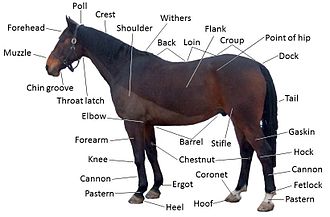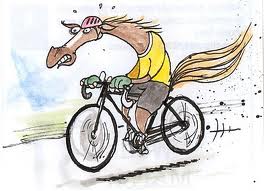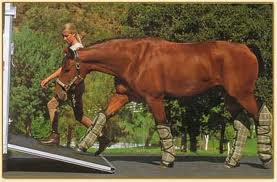Over recent years, quite a number of valuable horses have developed acute infection within the lung and chest commonly referred to as 'travel sickness' or 'shipping disease'.
Horses that have raced or been subjected to strenuous exercise immediately prior to long distance travelling are particularly prone to developing pleuropneumonia, which if not recognised and treated early, is invariably debilitating and may be fatal.
|
|
|
Cause Top Low grade viral infection, breathing contaminated air in poorly ventilated transports and the stress of travel appear to be the main underlying causes.
Travel stress includes:
- noise
- cramped spaces
- high speed driving
- swaying of trailers, and
- inadequate rest stops.
'Short tying' the head can lead to the spread of bacteria from the nose and mouth area into the deeper parts of the respiratory tract, predisposing the horse to travel sickness. The risk of travel sickness is increased if horses are unable to put their heads down to drain normal respiratory secretions.
Travel sickness is also a problem in horses travelled by air over long distances. Studies have shown that general airborne contamination is highest at the rear of the aircraft and transports, and horses travelling at the rear are most likely to develop the condition.
Transporting horses which are suffering from underlying viral disease, or are tired and dehydrated after racing or competition, increases the risk.
Dusty feed and hay containing bacterial germs and moulds, and breathing in dust from roads, results in inhaled contamination, which overloads the lungs' defence system. Unfortunately, many modern 'streamlined' floats and horse transports are often poorly ventilated.
|
Symptoms Top It is important to watch for and recognise the tell-tale signs early, especially during the few days following a long trip.
Horses with early pleuropneumonia:
- become depressed
- develop a fever
- go off their feed, and
- pant in shallow, rapid breaths.
Early signs may be confused with colic, as horses resist moving, stand with the front legs apart, and paw the ground. As the condition worsens, the horse may turn to look at its painful chest.
Immediate veterinary advice should be obtained. Unfortunately, once pleuropneumonia worsens, it is difficult to treat, and can result in death within 3-5 days.
|
Prevention Top
- Always ensure that horses are cooled down, and given a drink before long distance travel. In very tired, dehydrated or stressed horses, long distance travel of over 12 hours duration should be delayed until they recover, preferably at least overnight.
- Ensure ventilation is sufficient to keep air flowing without causing chills. An adequate rate of air change is important in large transports carrying a number of horses over long distances.
- Provide dampened feed or pellets to reduce dust and airborne contamination. Lightly dampen hay, in particular, by wrapping a biscuit of hay in a wet chaff bag for 2-4 hours to reduce dust and other airborne contamination. This will increase palatability of hay and provide additional moisture during long trips. Locate feeders below chest bar height.
- Do not tie the head too short - give the horse as much space as possible to feel comfortable and be able to put its head down. Stallion dividers may be required to prevent horses squabbling during transport.
- Avoid transporting horses suffering from respiratory disease. If a horse has symptoms, do not transport it as it may infect others during the trip.
- Ensure the trailer is in good condition and level on the towbar. Drive steadily and smoothly. Keep the back flap down to reduce intake of swirling dust on dirt roads.
- Stop every 3-4 hours and open the trailer doors. If possible, unload and allow the horse(s) to walk around, or preferably graze or feed with the head down for at least 15-20 minutes. Provide access to drinking water at rest stops. A 60ml dose of Recharge over the tongue will replace electrolytes and stimulate drinking.
- If a horse has competed or raced hard, give it a day off after a long trip. Turning the horse into a grassy green paddock to graze with its head down for a few hours, or putting dampened feed in a bin at floor level, will encourage drainage of the respiratory system.
- After travelling a horse over a long distance, keep a careful watch for loss of appetite, depression, fever and obvious discomfort for the first few days. It is a good idea to monitor the horse's temperature morning and night for at least 3 days after long trips, and seek vet advice if the temperature is elevated (the normal body temperature of an adult horse is 36.5-38.5°C).
|











